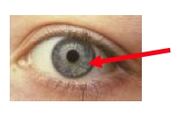Definition

Iris
Iris recognition is
| “ | A biometric modality that uses an image of the physical structure of an individual's iris for recognition purposes. . . . The iris muscle is the colored portion of the eye surrounding the pupil.[1] | ” |
Overview
Iris recognition technology is based on the distinctly colored ring surrounding the pupil of the eye. Made from elastic connective tissue, the iris is a very rich source of biometric data, having approximately 266 distinctive characteristics. These include the trabecular meshwork, a tissue that gives the appearance of dividing the iris radially, with striations, rings, furrows, a corona, and freckles. Iris recognition technology uses about 173 of these distinctive characteristics. Formed during the eighth month of gestation, these characteristics reportedly remain stable throughout a person’s lifetime, except in cases of injury.
How it works
Iris recognition systems use a small, high-quality camera to capture a black-and-white, high-resolution image of the iris. They then define the boundaries of the iris, establish a coordinate system over the iris, and define the zones for analysis within the coordinate system. The visible characteristics within the zones are then converted into a 512 byte template — a set of data that maps the patterns of the iris and the location on the iris where the patterns exist.
The template can be used to identify or verify the identity of an individual.
Having only become automated and available within the past two decades (the automated method of iris recognition has existed in patent only since 1994.[2] The iris recognition concept and industry are still relatively new. Continued research and testing remains an important component of the field of iris recognition.
Privacy
A privacy protection analysis would look to the reasoning for using iris recognition in a particular application and the nature and weight of matching within the system. This understanding would establish a context within which to evaluate the impact these matches may have on the decision-making practices of the organization and, ultimately, on the experiences of the individual.
References
- ↑ Biometrics Identity Management Agency, Biometrics Glossary, at 38 (Ver. 5) (Oct. 2010) (full-text).
- ↑ See John Daugman, "Iris Recognition for Personal Identification."[1]
Sources
- Information Security: Challenges in Using Biometrics, at 8 .
- Privacy and Biometrics: Building a Conceptual Foundation, at 16-17.